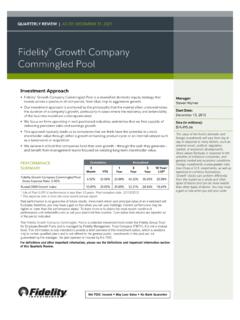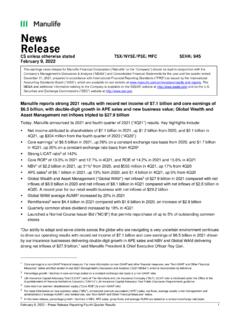Transcription of Growth and economic crises in Turkey leaving behind a ...
1 EUROPEAN COMMISSIONG rowth and economic crises in Turkey : leaving behind a turbulent past?Mihai Macovei economic Papers 386| October 2009 EUROPEAN ECONOMY economic Papers are written by the Staff of the Directorate-General for economic and Financial Affairs, or by experts working in association with them. The Papers are intended to increase awareness of the technical work being done by staff and to seek comments and suggestions for further analysis. The author is grateful for the valuable comments and suggestions received from Johan Baras, Peter Grasmann, Nikolay Gertchev, Carole Garnier, Christophe Pavret de la Rochefordiere, Dirk Verbeken, Uwe Stamm and Guray Vural.
2 The views expressed are the author s alone and do not necessarily correspond to those of the European Commission. Comments and enquiries should be addressed to: European Commission Directorate-General for economic and Financial Affairs Publications B-1049 Brussels Belgium E-mail: This paper exists in English only and can be downloaded from the website A great deal of additional information is available on the Internet. It can be accessed through the Europa server ( ) ISBN 978-92-79-13361-9 DOI: European Communities, 2009 Growth and economic crises in Turkey : leaving behind a turbulent past? 1. Overview A first glance at Turkey 's performance in the current crisis shows that it has managed to weather the global stormy conditions relatively well and avoid collapsing into a full-fledged currency and financial crisis.
3 Although activity in the real sector has contracted sharply, mainly as a result of both collapsing external demand and strongly declining domestic demand - which is also a by-product of the international credit crunch and lower availability of external financing, a financial crisis similar to those in the 1990s and in 2000/2001 has been avoided. On the face of it, one could conclude economic reforms introduced since 2001 have paid off and today's performance marks a clean break with the past. But there are also indications that the Turkish economy still retains some of its old vulnerabilities. Warning signs include developments related to the timing of the economic slowdown, the fairly large correction of the exchange rate at the beginning of the crisis, concerns regarding the external indebtedness of the private sector and the numerous voices calling for policy anchors, such as the introduction of binding fiscal rules or a new IMF arrangement.
4 The main purpose of this paper is to assess whether the current economic crisis which affects not only Turkey , but countries around the world, has any significant similarities to the crises that engulfed Turkey in the 1990s. One immediately obvious difference is that while in the 1990s the factors triggering Turkey 's economic instability were largely domestic its current crisis has paralleled the international financial and economic turmoil. But, these different trigger factors notwithstanding, it is still useful to compare how the Turkish economy has behaved in the two crisis situations in order to ascertain whether and to what extent macroeconomic and structural policy shortcomings have been corrected.
5 It is also important to determine how resilient Turkey 's economy is to domestic and international economic volatility in order to assess the sustainability of the accelerated economic convergence process on which Turkey embarked after the 2001 crisis. The paper is organised as follows. The second chapter examines Turkey 's economic performance and Growth dynamics after the Second World War and identifies the main causes and features of the financial and economic crises which plagued it in the 1990s. It briefly analyses the major contributors to the unstable Growth model that prevailed in past decades and what lessons the authorities drew from the 2000-01 crisis.
6 This scene-setter leads on to a presentation of the post-crisis economic reforms and the comparative assessment with the current crisis. The third chapter focuses on the economic recovery which started in 2002 based on remarkable fiscal consolidation and improved macro-financial stability and led to uninterrupted strong Growth and economic catching-up until the second half of 2008. The impressive economic rebound occurred against the background of strong external anchors IMF programmes and an improved perspective for EU accession and bold structural reforms. The fourth chapter looks in-depth at the ongoing economic crisis and its impact on the real economy, financial and external sectors, together with the policy responses and the challenges faced by the authorities.
7 The last chapter asks whether the current crisis shows that Turkey has broken with its past economic instability. Improved macroeconomic stability and an implicit break with the volatile Growth pattern of the recent past would represent in our view a precondition for fully utilising Turkey 's potential for economic catching-up. 1 2. Causes and features of past economic crises From the Second World War until the 2001 economic crisis, Turkey s economic catching-up with the developed economies was weak and volatile. The low productivity Growth and relative stagnation through the 1970s was primarily the result of policies of import substitution, subsidisation of agriculture and economic dirigisme which resulted in a sub-optimal allocation of resources.
8 And in spite of some steps towards reform and liberalisation in the 1980s, economic Growth was plagued by recurrent crises , as a result of inadequate macro- economic policies and financial opening in a weak institutional and regulatory environment. The volatile Growth pattern culminated in the 2000/2001 crisis which led to the breakdown of the currency peg to the US dollar, a sharp depreciation of the Turkish lira, and a contraction of GDP by in real terms in 2001. But there was a silver lining: the strong incentive the crisis created for bold reforms led to five years of economic recovery during 2002-07.
9 Anaemic catching-up process until the 2001 economic crisis Turkey was largely spared the horrors and economic destruction of the Second World War, mainly because it maintained armed neutrality. However, its economy stagnated during the 1940s, in large part because of the strongly curtailed foreign trade and increased military expenditure. After the war, it was nevertheless well positioned to engage in a robust process of economic convergence with the United States, like the Western European economies, but it failed to take advantage of the effervescent post-war economic reconstruction (table 1). The period 1950-1973 is regarded as a "Golden Age" in modern European economic history as it combined very high rates of Growth with relatively mild cyclical fluctuations and moderate inflation.
10 * Union ** 1: Changes in real GDP per capita, 1950-1998(Average annual Growth rates)* 1950-1990 and 1950-1998: West Germany, 1990-1998: unified Germany.** 1950-1998, 1950-1960 and 1950-1973: Luxembourg is : UN economic Commission for Europe It saw Western Europe's fastest rate of output expansion since the beginning of "modern Growth " in 1870. According to the United Nations economic Commission for Europe1, real GDP per capita increased by almost 4% annually between 1950 and 1973, well above the 1 See the " economic Survey of Europe", 2000 No. 1. Growth recorded in the United States.












